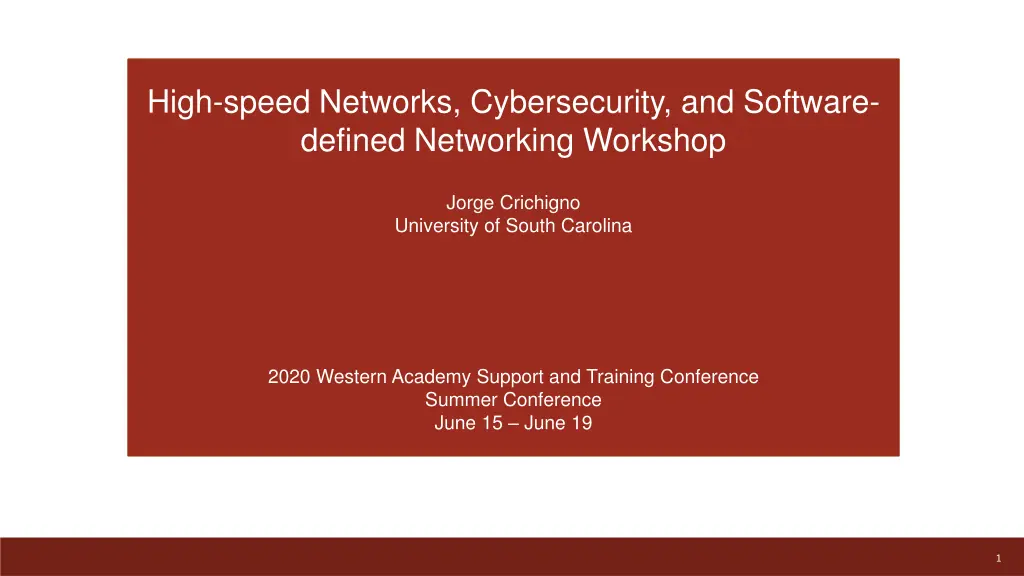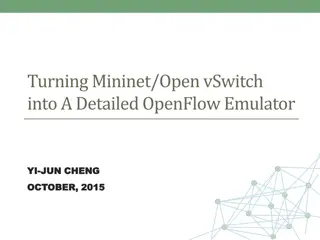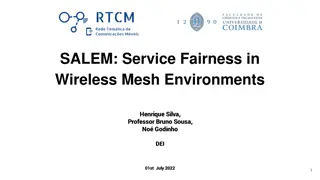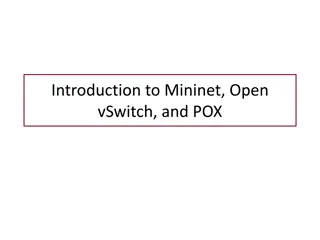
Introduction to Mininet: Virtual Networking for Development
Explore Mininet, a virtual testbed enabling network development and testing. Learn how to create realistic virtual networks on any machine, prototype new protocols, test complex topologies, and more. Enhance your skills in networking, teaching, and research with Mininet's open-source environment and extensive documentation.
Uploaded on | 0 Views
Download Presentation

Please find below an Image/Link to download the presentation.
The content on the website is provided AS IS for your information and personal use only. It may not be sold, licensed, or shared on other websites without obtaining consent from the author. If you encounter any issues during the download, it is possible that the publisher has removed the file from their server.
You are allowed to download the files provided on this website for personal or commercial use, subject to the condition that they are used lawfully. All files are the property of their respective owners.
The content on the website is provided AS IS for your information and personal use only. It may not be sold, licensed, or shared on other websites without obtaining consent from the author.
E N D
Presentation Transcript
High-speed Networks, Cybersecurity, and Software- defined Networking Workshop Jorge Crichigno University of South Carolina 2020 Western Academy Support and Training Conference Summer Conference June 15 June 19 1
Lab 1: Introduction to Mininet 2 Introduction to Mininet
Content Introduction to Mininet Invoking Mininet using the CLI Building and emulating a network in Mininet using the GUI 3 Introduction to Mininet
Section 1: Introduction to Mininet 4 Introduction to Mininet
Mininet Mininet is a virtual testbed enabling the development and testing of network tools and protocols It creates a realistic virtual network on any type of machine (VM, cloud-hosted, or native) It is an inexpensive solution and streamlined development running in line with production networks Mininet offers the following features Fast prototyping for new networking protocols Simplified testing for complex topologies without the need of buying expensive hardware Realistic execution as it runs real code on the Unix and Linux kernels Open source environment backed by a large community contributing extensive documentation Mininet is useful for development, teaching, and research Originally designed to experiment with Software-Defined Networking (SDN) 5 Introduction to Mininet
Mininet Mininet provides network emulation opposed to simulation, allowing all network software at any layer to be simply run as is Mininet s logical nodes can be connected into networks Nodes are sometimes called containers, or more accurately, network namespaces Containers consume sufficiently few resources that networks of over a thousand nodes have been created, running on a single laptop 6 Introduction to Mininet
Mininet Nodes A Mininet container is a process (or group of processes) that no longer has access to all the host system s native network interfaces Containers are then assigned virtual Ethernet interfaces, which are connected to other containers through a virtual switch Mininet connects a host and a switch using a virtual Ethernet (veth) link The veth link is analogous to a wire connecting two virtual interfaces 7 Introduction to Mininet
Section 2: Invoking Mininet using the CLI 8 Introduction to Mininet
Starting Mininet using the CLI To start a minimal topology, enter the command sudo mn at the CLI 9 Introduction to Mininet
Useful Commands To display the available nodes, type nodes To display the links between the devices, type net 10 Introduction to Mininet
Useful Commands To execute commands at a specific device, type the device first, followed by the command For example, to execute the command ifconfig on host h1, type h1 ifconfig 11 Introduction to Mininet
Useful Commands To test connectivity between end-hosts, use the ping command. Type h1 ping 10.0.0.2 to test the connectivity between host h1and host h2 (10.0.0.2) 12 Introduction to Mininet
Section 3: Building and emulating a network in Mininet using the GUI 13 Introduction to Mininet
MiniEdit MiniEdit is a simple GUI network editor for Mininet 14 Introduction to Mininet
MiniEdit To build Mininet s minimal topology, two hosts and one switch must be deployed 15 Introduction to Mininet
Host Configuration Configure the IP addresses at host h1 and host h2 A host can be configured by holding the right click and selecting properties on the device 16 Introduction to Mininet
Starting Emulation Before testing the connection between host h1 and host h2, the emulation must be started Click on the Run button to start the emulation The emulation will start and the buttons of the MiniEdit panel will gray out, indicating that they are currently disabled 17 Introduction to Mininet
Executing Commands on Hosts Open a terminal on host by holding the right click and selecting Terminal 18 Introduction to Mininet
Testing Connectivity On host h1 s terminal, type the command ping 10.0.0.2 19 Introduction to Mininet
Stopping Emulation Stopping the emulation removes: Network namespaces (nodes) Virtual interfaces Links between switches and hosts Stops the virtual switches instances Stop the emulation by clicking on the Stop button 20 Introduction to Mininet






















